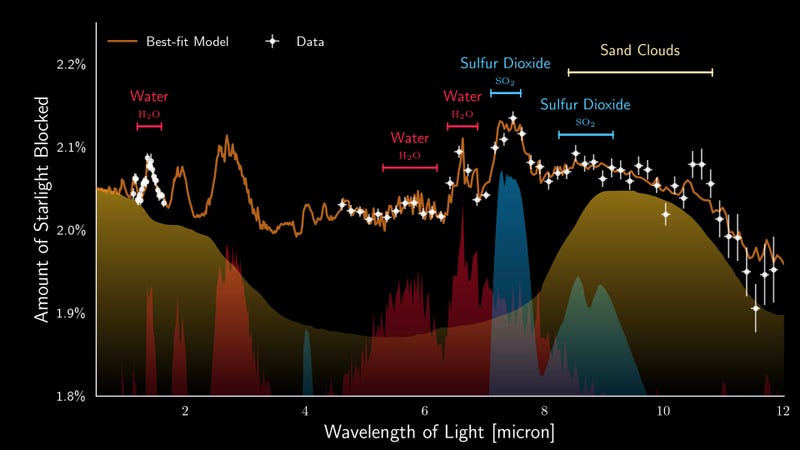The Webb Space Telescope has revealed a world quite alien compared to our own: WASP-107b, a Neptune-like gas giant that orbits a star some 211 light-years from Earth. Webb has now detected water vapor and sulfur dioxide in the planet’s atmosphere, as well as sand-like silicate clouds.
The planet’s atmosphere is not dense, allowing a team of astronomers to peer deeply into the world using the telescope’s Mid-Infrared Instrument (MIRI). The team’s work was published today in Nature.
“The discovery of clouds of sand, water, and sulfur dioxide on this fluffy exoplanet by JWST’s MIRI instrument is a pivotal milestone,” said Leen Decin, an astronomer at KU Leuven and the study’s lead author, in a university release. “It reshapes our understanding of planetary formation and evolution, shedding new light on our own Solar System.”
Lucky for the scientists, WASP-107b is almost the size of Jupiter, despite having a mass similar to Neptune. Because the planet has a less dense, “fluffy” constitution (as described in the release), the team was able to look much deeper into its atmosphere using Webb than is possible for a world like Jupiter. (Though just last month, Webb spotted a high-speed jet in Jupiter’s lower stratosphere.)
Besides studying known exoplanets, Webb is also discovering them; it found its first world in January. Its first images of an exoplanet—albeit one already known to science—were released months earlier. Like the sandy clouds of WASP-107b, Webb previously observed gritty clouds on VHS 1256b, an exoplanet about 40 light-years from Earth. And in 2022, the space observatory revealed the noxious atmosphere of a hot Saturn 700 light-years from us. Two months ago, the telescope spotted a tenuous signal of dimethyl sulfide, a molecule known on Earth for being produced by living organisms.

WASP-107b’s host star is relatively cool, and doesn’t emit many high-energy photons. But because of the planet’s airy constitution, the photons the star emits can penetrate deep into WASP-107b’s atmosphere, catalyzing the reactions that produce the sulfur dioxide recently spotted by the team.
The planet is warm, with temperatures of about 932°F (500°C) in its outer atmosphere, clueing researchers into how the planet’s sand clouds are produced. “The fact that we see these sand clouds high up in the atmosphere must mean that the sand rain droplets evaporate in deeper, very hot layers and the resulting silicate vapor is efficiently moved back up, where they recondense to form silicate clouds once more,” said Michiel Min, an astronomer at the University of Amsterdam and co-author of the study, in the same release. “This is very similar to the water vapor and cloud cycle on our own Earth but with droplets made of sand.”
Webb’s sweeping look at exoplanets near and far is not only teaching astronomers about the diversity of worlds out there, but the vanishingly few worlds that may actually be habitable by our terrestrial standards. Finding habitable worlds is a top priority of American scientists in the next decade, as outlined by a report published in 2021.
Webb is still a relative newcomer to space, but NASA is already designing plans for its successor: the Habitable Worlds Observatory, a mission dedicated to finding those rare habitable planets beyond our solar system. It could be operational by the early 2040s, but until then, Webb will clue us in to what alien worlds look like.
